Content
- 1 Methods for growing petunias from seeds
- 2 Features of growing petunias
- 3 Diving and caring for petunia seedlings
- 4 How to grow petunia seedlings from seeds
- 5 Should you buy ready-made seedlings?
- 6 Petunia seedling care
- 7 Diseases and pests
- 8 Rules for preparing seedlings for transplanting into open soil
- 9 How to grow petunia seedlings at home: general recommendations
- 10 How to properly care for seedlings
- 11 How to plant petunia in open ground
 Any garden will be decorated with petunia, abundantly blooming in various colors all summer and autumn. In addition, petunia is unpretentious, not demanding in care.
Any garden will be decorated with petunia, abundantly blooming in various colors all summer and autumn. In addition, petunia is unpretentious, not demanding in care.
Therefore, many are interested in how to grow petunia from seeds - planting features, caring for seedlings and an adult flower.
Methods for growing petunias from seeds
To get seedlings of petunias, you need to sow seeds in February or early March. To do this, you can use seedling containers, or apply the technology of growing petunias using peat tablets.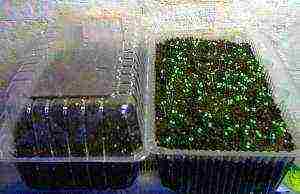
- Most often, seedling boxes are used for this purpose. The seeds of the flower are light-like, that is, they need light for germination. Therefore, the sowing is done superficial, it is impossible to sprinkle them with earth, and for better contact with the soil, it is enough just to press.
- Seeds germinate at a sufficiently high temperature, about +25 ° C and an air humidity of 98%.
Such conditions can be ensured by placing the seedling boxes in a lighted warm place, covered with a light non-woven cloth. You can use glass or transparent film for this purpose, however, the non-woven fabric provides the seeds with a more favorable growing environment, since moisture is better retained and the seedlings can breathe air.
The non-woven fabric is removed when the seedlings grow a little. - Sowing grains into peat tablets is much more efficient. Practice has shown that growing plants in peat tablets does not require subsequent diving, and grown seedlings can be planted directly into the ground.
 The advantage of the tablets is the natural properties of peat, its water and air permeability, besides, they contain enough nutrients necessary for the development and growth of seedlings.
The advantage of the tablets is the natural properties of peat, its water and air permeability, besides, they contain enough nutrients necessary for the development and growth of seedlings.
It is very convenient to use these tablets for growing petunias from seeds. They are placed in a container - a plastic container with a lid, and filled with water.
Within 10 minutes, the tablets will swell, increasing in height, but maintaining the diameter. After waiting another 5 minutes, drain the excess water and, using tweezers or a toothpick, place one seed in the depression that is in the upper part of the tablet. Then the container is closed with a lid and placed on the windowsill.
Further growing and caring for petunia consists in maintaining the temperature and humidity necessary for seed germination and growth.
To prevent condensation from dripping onto the sprouts, you need to periodically ventilate the container and remove excess moisture from its walls and lid.
Not everyone has the conditions to grow petunia seedlings in an apartment. It is quite possible to breed petunias in a greenhouse, however, the seedlings for planting in the ground will be ready a little later than home ones.
The main thing is to prepare the greenhouse in such a way as to provide the plant with the desired temperature and humidity conditions.
Features of growing petunias
Growing petunias indoors is troublesome, but very exciting.
The main thing is to ensure the light regime and maintain the required temperature.
Seedlings appear after about two weeks after sowing the seeds. This is a signal that it is necessary to reduce the temperature of the seedlings: during the day it should not exceed 20 ° C, and at night 16 ° C.
So that the sprouts that appear do not stretch out and grow well, they do additional lighting using a variety of phytolamps.
Additional lighting should be started as soon as the sprouts hatch. It is desirable that the plantings are illuminated for approximately 16 hours a day. This helps the seedlings grow strong and healthy, and further accelerates the formation of flower buds.
Diving and caring for petunia seedlings
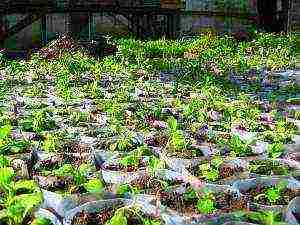 Seedlings dive when the first full-fledged leaves appear.
Seedlings dive when the first full-fledged leaves appear.
In the agrotechnology of growing petunias, this is perhaps the most crucial moment. The sprouts are very delicate and fragile, for planting them you will need maximum patience and accuracy so as not to injure them.
For transplantation, cups made of transparent material filled with sterilized soil are used. In them sprouts are transplanted, dug out together with a lump of soil near the root.
Seedlings at the germination stage are quite capricious.
For about a month after the emergence of the sprouts, their development proceeds very slowly, since at this stage they build up the root system. More active growth begins when the seedlings are one and a half months old.
When the soil in a transparent cup is strongly intertwined with roots, the sprouts are transplanted into larger pots (up to 2 liters) and left there until planting in a permanent place.
 The cultivation of ampelous petunias from grains, as well as the cultivation of cascading flowers, is carried out using the same technology as for other varieties.
The cultivation of ampelous petunias from grains, as well as the cultivation of cascading flowers, is carried out using the same technology as for other varieties.
Ampel petunia is the best option for hanging planters.
The ampelous group also includes cascade varieties. They have flexible, but thicker and shorter stems than ideal ampelous forms.
Growing terry petunia, surfinia petunia has its own characteristics. The fact is that they do not give seeds, therefore they propagate by cuttings of shoots.
To do this, a shoot with two internodes is cut off from a flowering bush. Flowers and buds are removed. The tip of the cutting is "powdered" with root and planted in a glass, which is set in the shade. After 3 weeks, roots appear. Plants overwinter in the house, at a temperature of 16 ° C.
How and with what water to water petunia seedlings
It is very important to learn how to water petunia seedlings. This should be done in moderation and on time, observing some rules:
- Watering with a watering can is absolutely excluded. A fine spray gun is best suited to moisten the substrate. Waterlogging of the soil is dangerous by the appearance of a "black leg" - a disease in which the sprouts rot from below and die. Drying out is also detrimental to tiny seedlings.
- The most reliable way to maintain the correct soil moisture is to water the seedlings from the bottom of the pallet, not from the top.
- Use soft, chlorine-free water for irrigation. Therefore, be sure to defend tap water for at least a day, and immediately before watering, add a little lemon juice.
- Water and substrate must be at the same temperature.
Important! In sunny weather, seedlings should be watered in the evening, since it is at night that their growth is most intense and water consumption is greater, while during the day the water evaporates strongly.
By fulfilling these little secrets of breeding petunias, we get a full-fledged seedlings
What soil is needed for petunias?
For sowing seeds, it is allowed to use various soil mixtures based on peat, with the exception of alkaline and strongly acidic ones.
Self-preparation of the potting mix requires certain skills, and the constituent components need to be sought somewhere, so the best option is to purchase a substrate in a flower shop.
It contains in an optimal ratio all the necessary substances for plant nutrition and growth.
To protect the plant from diseases, the acquired mixture must be spilled with a fungicide before planting.
Fertilizers for petunias
 A plant cannot grow full-fledged without the use of fertilizers throughout its development. Petunia is incredibly responsive to fertilization, and has a high need for them. Only when it receives the necessary fertilizing in abundance, it will bloom profusely until the coldest days.
A plant cannot grow full-fledged without the use of fertilizers throughout its development. Petunia is incredibly responsive to fertilization, and has a high need for them. Only when it receives the necessary fertilizing in abundance, it will bloom profusely until the coldest days.
Try to use only specialized fertilizers, otherwise it is very difficult to maintain the concentration. Complex fertilizers with a high potassium content are also excellent for fertilizing.
At home, the easiest way is to use liquid fertilizers, which are diluted with water before watering. Their choice is wide enough.
Feeding should start a couple of weeks after transshipment. Throughout the season, you need to continue to fertilize at intervals of two weeks.
In addition to feeding, caring for petunia involves periodically loosening the soil to ensure oxygen supply to the roots and watering.
Caring for adult petunias, many do not know that in order to form lush bushes, it is necessary to pinch, that is, remove, the tops of regrown shoots. This should be done in the phase of active growth, when 4-5 leaves are formed.
Petunias bloom profusely and for a long time. They are planted in flower beds, in vases and containers, used to decorate flower beds. With a little effort and time to grow seedlings, you can plant the beauty of this delightful flower all season.
Article when to plant petunias for seedlings!
Growing and caring for petunias - video
Such incredibly beautiful flowers as petunias can be a wonderful decoration not only for a garden, but also for a house, as well as a terrace, a balcony, etc. This plant is one of the longest and most lush-flowering plants, and it is also distinguished by a variety of varieties, colors and shapes. ... Petunia is usually grown as an annual. However, there are some difficulties in growing petunia seedlings. So, in order for this event to be successful, it is necessary to sow such a plant at a certain time.
How to grow petunia seedlings from seeds
Seedling mix suitable for seedlings

A slightly acidic or neutral soil mixture is suitable for growing seedlings. It should be loose, rich in nutrients, able to retain water without getting too wet. You can buy a similar soil mixture, or rather, the universal Stender soil, in a specialized store. However, you will need to add additives to this soil. So, for 5 liters of soil, a five hundred gram jar of wood ash, 250 grams of perlite, and another 1 large spoon of Kemira or potassium sulfate are taken. The soil mixture can be prepared with your own hands. To do this, it is necessary to combine humus, sod soil, sand, as well as well-decomposed peat, which must be taken in a ratio of 2: 2: 1: 2. You can prepare a suitable mixture of sand, garden soil and peat, which are taken in a 1: 1: 2 ratio. The finished soil mixture must be sieved 2 times with a sieve. So, the first time you need to use a coarse sieve, and the second time - a finer sieve. Then the ground must be watered with a solution of Previkur (cook according to the instructions) or manganese potassium (strong).
Sowing petunias for seedlings
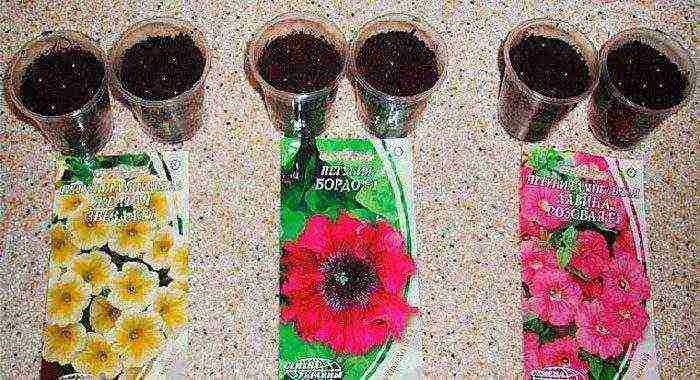
Seeds should be purchased only those that are made by a trusted manufacturer, otherwise you will have to wait a long time for seedlings if they appear at all. If you use pelleted seeds for planting, then somehow you should not particularly prepare them for planting. But it is worth remembering that in dry soil they grow extremely poorly, since the layer covering them cannot dissolve. When buying simple seeds, you need to ask the seller how to store them correctly and for how long it is possible.It is recommended to use fresh seeds for planting, since it is the low germination rate that is the main difficulty in growing such plants.
For planting, it is recommended to use a box made of wood or plastic, the height of which should be about 10 centimeters. In this case, special holes for drainage must be made at the bottom of the container. Treat the bottom of the box with a potassium manganese solution, and then rinse it with clean water. Lay a layer of small expanded clay at the bottom, and on top of it pour the prepared earth mixture. In this case, it is necessary that the earth does not reach the upper edge of the container by 2 centimeters. These seeds do best when sown on snow, so if there is snow outside, place it on top of the soil and compact slightly. The seeds are sown directly into the snow. Then the box is covered with glass or foil. After the snow layer has melted, the seeds will be sucked into the substrate. In the absence of snow, sowing is carried out on the surface of a wet substrate, and then the seeds are sprayed on top with a fine spray gun. After that, the box also needs to be covered with glass or film. The seeds should not be buried in the soil or sprinkled with even a thin layer of earth, because they germinate only in the presence of light. For more even sowing, it is recommended to mix small seeds with a small amount of dry sand. Place the container in a well-lit and warm (about 25 degrees) place.
Growing seedlings in tablets
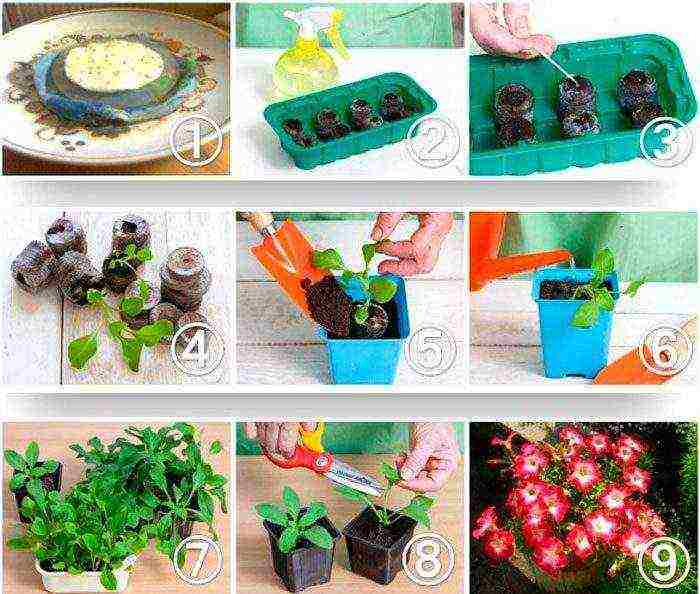
If you purchased pelleted seeds, then it is best to use special peat tablets for sowing them. For this purpose, medium-sized tablets (diameter 3.5 or 4.5 centimeters) are suitable. To begin with, a peat tablet must be immersed in water in order for it to become soaked. After that, the excess liquid is removed, and the prepared tablets must be placed in a tray with high edges. Then, using a toothpick or an ordinary match, 1 seed is placed in each tablet. Then watering is carried out with a pipette, which will allow the layer of substance covering the seed to be soaked. After a few minutes, using your fingers, smear the shells, which should be limp by that time. This will allow the seeds to germinate faster. Then the container on top should be covered with a film or glass and placed in a well-lit, warm (about 25 degrees) place.
This method of growing helps to increase the germination of petunias. And also flower growers note that it is much easier to care for such seedlings, because they do not need to be planted, and you can also easily understand when the plant needs watering.
Growing seedlings of petunias in cassettes
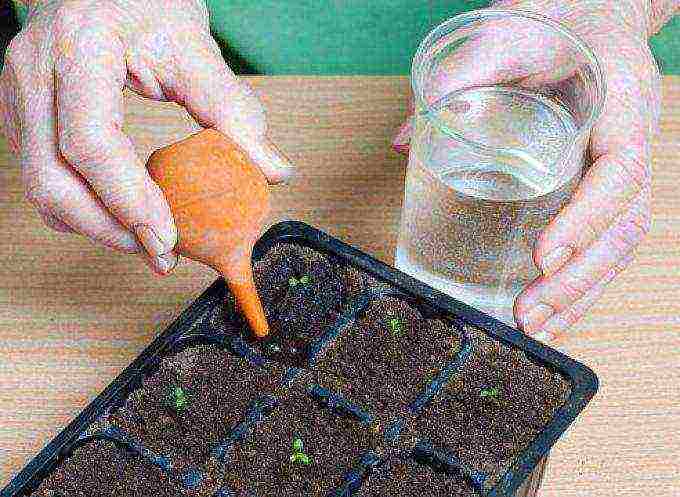
Growing in cassettes, according to most growers, is a very convenient and also relatively economical way. Thus, a cassette with cells is designed for repeated use, and the plants planted in it do not need further picking. If desired, you can purchase cassettes with a different number of cells. However, it should be taken into account that the more cells are in the cassette, the smaller they are. For sowing petunias, experts advise those cassettes whose cells are large enough, while their height should not be less than 10 centimeters. The cells can be filled with the soil mixture mentioned above, but peat tablets are also placed in them if desired. You need to care for such seedlings in the same way as for those grown in simple boxes.
Should you buy ready-made seedlings?

The question of buying ready-made petunia seedlings is of particular concern to inexperienced flower growers, since not every one of them is able to grow it on their own. If you want to grow petunia yourself, you just need to buy high-quality seeds and adhere to the above sowing rules.However, if the grower does not know how to grow seedlings at all and it scares him, then it is quite possible to purchase ready-made petunia seedlings, only this must be done in such a flower shop that inspires confidence. By the way, in spring it is very easy to do this, since this seedling is not a deficit.
However, before you go for petunia seedlings, you need to remember a few rules that will help you choose high-quality and healthy plants:
- the substrate in which the petunia grows should in no case be wet;
- seedlings with dried tops and yellowish leaves are most likely sick with chlorosis and the plants are already dying of the root system;
- do not take an overgrown petunia, as these plants in open soil can either begin to stretch out or stop growing altogether (depending on how badly the roots have suffered);
- inspect the seamy side of the foliage, as there may be pests.
Petunia seedling care
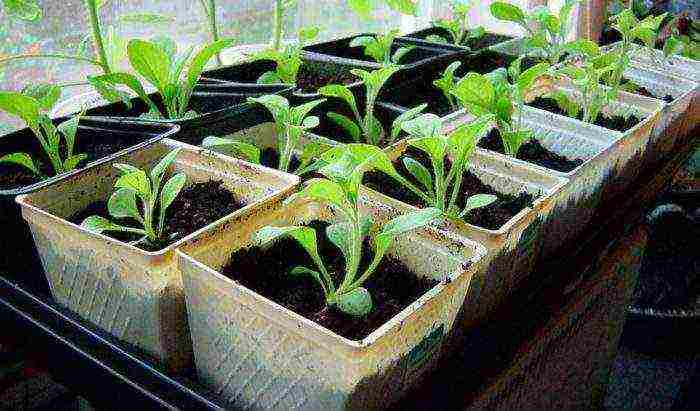
Optimal growing conditions
Best of all, the seeds of these flowers germinate at a temperature of 24 or 25 degrees. Hybrids are especially demanding on temperature. So, if it is colder, then they will not sprout, and in warmer conditions, the plants begin to hurt, and their stems become elongated. In that case, if the required temperature and good lighting are provided, then the first shoots can be seen already 5-7 days after sowing. When this happens, the seedlings will need to be ventilated a couple of times a day. To do this, you need to remove the shelter, while removing water droplets from it. The first time you need to open for 20 minutes, then 40 minutes, etc. At the same time, you need to lower the air temperature. So, during the day it should be about 20 degrees, and at night - up to 16 degrees. At first, the plants are characterized by extremely slow growth. The fact is that at this time their roots are actively growing and developing. It should also be remembered that seedlings in the last days of February and in the month of March require illumination. In cases where the petunias grow very thickly, thinning will be required, which can be done with tweezers.
The cover is removed for good only after the plants begin to touch it. However, it is important at this time to maintain the moisture content of the substrate at the same level.
Illumination of petunia seedlings
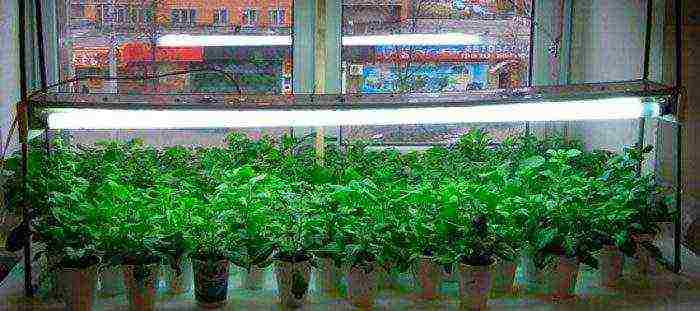
In order for newly emerged petunias to develop and grow normally, they need almost round-the-clock lighting. If the plants are provided with good lighting, then this will accelerate their growth, as well as significantly bring the beginning of flowering closer. Then such flowers need to provide daylight hours, the duration of which should be equal to 11-12 hours. In this case, the maximum illumination should be equal to 50 thousand lux. To do this, additional lighting must be turned on early in the morning (7-8 hours), and turned off late in the evening (21-22 hours). When the pick is made, the illumination level should be slightly increased to 55 thousand lux.
For illumination, LED, fluorescent, gas-discharge lamps, as well as special phytolamps are suitable. They must be installed above the seedlings at a height of about 20 centimeters.
How to water properly
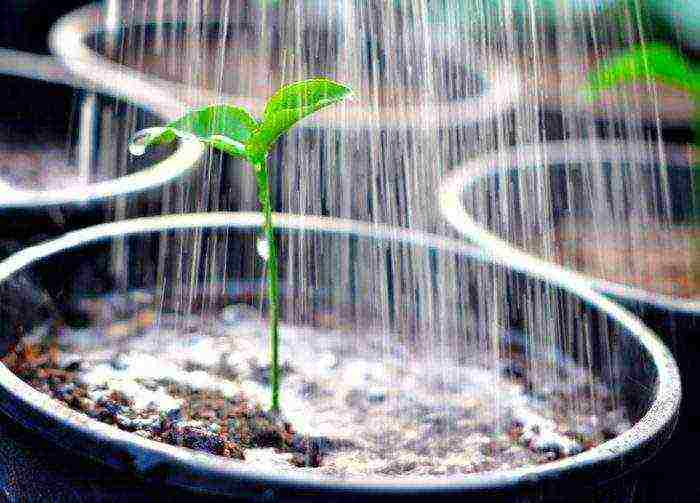
For petunia seedlings, proper watering is very important. The fact is that such a plant needs moderate moisture. So, if the soil is too damp, this will lead to the appearance of rot and fungal diseases, and drying out the substrate can be fatal for young plants. Drip irrigation is recommended for such seedlings. So, using a syringe, water should be dripped directly under the root of the plant, while trying to ensure that the liquid does not fall on the surface of the foliage in any case. You can also pour liquid along the side of the tank while watering. And such a plant can also be watered through the pallet.
Only soft and well-settled water should be used for irrigation (it should not contain chlorine).You can use both lukewarm water and room temperature. A couple of minutes before watering, a little freshly squeezed lemon juice should be poured into a container of water.
If the day is sunny, then watering must be arranged in the evening. And if the sky is clouded with clouds, then you need to water the plant in the morning.
Fertilizer

Young plants need a lot of nutrients, so they need to systematically fertilize the substrate. In the first 14 days after the emergence of shoots, it is necessary to spray the petunia with a weak solution of potassium manganese or Pervikur as the upper layer of the substrate dries out. When the plants begin to grow 3 and 4 real leaves, then a solution of yellow Kristalon must be added to the ground (for 5 liters of water ½ part of a large spoon). Top dressing is carried out both on foliage (especially if there are a large number of seedlings), and directly into the soil. Fertilizers such as Uniflora micro or Kristalon are excellent for leaf feeding. Grown seedlings need to be fed 3 times every 7 days, while it is recommended to use the foliar and root methods alternately.
After a couple of weeks, as the pick will be made, the plant should be sprayed with a solution of a product that stimulates root growth. For this purpose, it is recommended to use a remedy such as: Solution, Plantafol, Kemira lux, as well as Aquarin. In this case, the solution should be prepared exactly following the attached instructions.
It should be taken into account that in the case when an earth mixture enriched with nutrients was used for sowing, then it will be possible to do without additional fertilizing. However, when using poor soil, they are required.
Picking seedlings of petunia
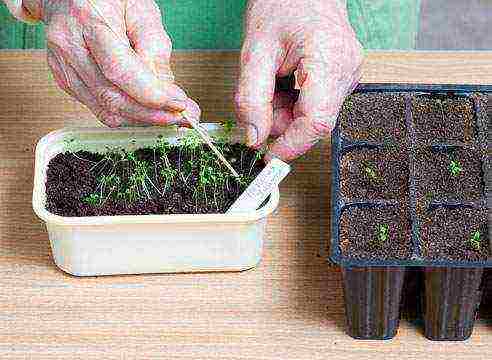
In the event that the seedlings were sown in a common box, they will need a pick as they grow. And that's all, because such a petunia is grown in the house for 8-12 weeks, and at the same time the plants have developed and sufficiently voluminous roots. For picking, it is recommended to use containers (cups), the volume of which is 200-250 mg, while at the bottom they must have holes for drainage. You need to dive petunia after it has 2-3 pairs of true leaves. The plant is captured together with an earthen lump, trying not to disturb the roots, and transferred to an individual container. Then so much earth mixture is poured so that there are no voids left in the glass. The transplanted plants are watered. After the soil has settled, the earth is poured into the container. In order to avoid pulling out the seedlings, 7 days after the pick, the temperature should be kept 3-4 degrees lower than usual. Also, seedlings must be protected at this time from direct sunlight. It happens that the plant has to dive 2 times.
When grown in tablets, if necessary, the plant can be planted in an individual container right with it.
The first feeding after the pick is recommended to be carried out no earlier than 1–1.5 weeks after it was carried out.
Pinching petunia seedlings
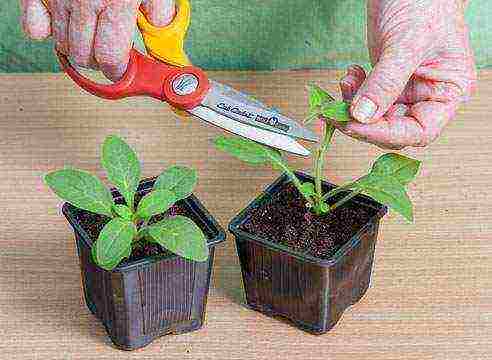
For the best branching of the petunia, you need a pinch. Strongly growing and hybrid varieties are pinched over 4 or 5 leaves, while breaking out the upper part of the stem along with the growing point. As a result, a young shoot will appear from each leaf sinus, and such a plant will bloom more abundantly. After half a month, the 2nd pinching is carried out, while it should be borne in mind that in order to obtain a very lush bush, it is necessary to perform this procedure several times.
Seedlings of ampelous varieties are not pinched, because this will have little effect on its branching. Such a plant is weakly branching.
Diseases and pests
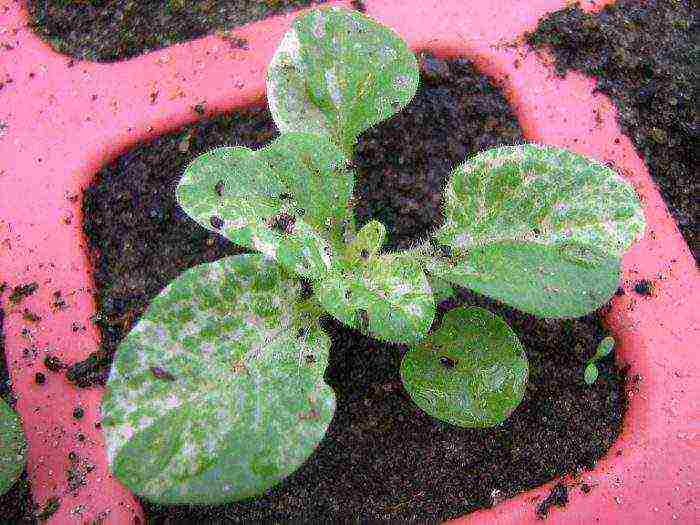
Most often, black leg disease develops, and excessive moisture can be the cause. At the very beginning, a dark spot appears at the base of the shoot, while the plant tissue becomes soft and rots.Then a constriction is formed in this place, and the shoot lays down under its own weight. Diseased plants should be destroyed. The place where they grew is spilled with a strong solution of potassium manganese, Maxim or Formalin (40%).
Also, such a plant often suffers from chlorosis (lack of iron). This can be due to alkalization of the soil as a result of overflows. In this case, a special iron chelate must be added to the soil, which is part of the Ferovit product.
A spider mite can also settle on the leaves, which really likes high dryness. It sucks out plant juice, and can also become a carrier of a dangerous viral disease. To combat it, it is recommended to use acaricidal drugs, for example: Neoron, Aktellik, Fitoverm, etc.
Rules for preparing seedlings for transplanting into open soil
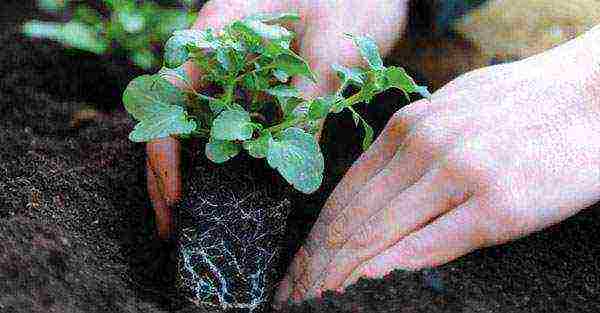
When the pick is left behind, the mature seedlings can be prepared for planting in open soil. Hardening is carried out throughout the crescent, while the plant should be accustomed to the street gradually. The first time the plants should be outdoors for 10 to 15 minutes, and then each day the duration of their stay should be increased. Immediately before planting, the seedlings should be outdoors around the clock. Petunia should be planted in the second half of May and the first - June.
For planting, you can choose any area of the soil. However, petunia will grow best in a well-lit area that has loamy, nutrient-rich soil. Remove weeds and debris from the soil and dig it up, it is recommended to add humus or compost.
Disembarkation is carried out in the evening at sunset or in cloudy weather. A hole of ten centimeters depth is made, while the distance between the plants directly depends on their variety. So, between the plants of ampelous varieties, a distance of about 28-30 centimeters is left, between small-flowered varieties - 18–20 centimeters, and between large-flowered varieties - 23–25 centimeters. Water the seedlings well, and then transfer them with the soil into the holes.
The planted plants should be watered, and the surface of the soil should be sprinkled with mulch (humus or peat). The first day after disembarkation, petunia should be shaded from direct sunlight using cardboard boxes or a special canopy.

Don't know how to decorate your balcony, loggia, garden, or simply the windowsill of your apartment? Then this article is for you. We will tell you about the beautiful petunia, which is perfect for decoration.
Petunia is a herbaceous perennial semi-shrub plant of tropical origin. It attracts attention with its large and bright colors. Combines harmoniously with other garden plants. Therefore, it is often used to decorate a garden or terrace. Quite often, flower growers choose it to decorate balconies, loggias and even apartment windowsills.
It is believed that adult petunia is very whimsical, and young sprouts are still fussy. But, despite this, if you approach the process of growing and caring for petunia correctly, everything will work out and you will admire its beautiful flowers for a long time, so in this article we will look at how to grow a plant without mistakes from "A" to "Z" ...
…

Bright petunia is good for everyone: beautiful flowers of various shades, splendor, long flowering, unpretentiousness. However, not every gardener succeeds in decorating his plot with these popular flowers, the reason for this is the difficulty of growing seedlings.
Since the cost of the finished planting material is quite high, the device of a large flower bed will require considerable financial costs. It's better to learn how to get sprouts on your own, even if it takes some time. But, knowing from personal experience how to properly grow petunia seedlings, in the future it will be much easier for you to grow any other flowers.

If you want to get flowering plants earlier, start sowing seeds at the end of January.
It is best to plant petunias in open ground in mid-June, which means that you should start sowing seeds from mid-March. It takes about 12-13 weeks for the seedlings to get stronger, the root system becomes stronger, and the first flowers appear. If you want to get flowering plants earlier, start sowing seeds at the end of January.
Video about growing petunias
How to grow petunia seedlings at home: general recommendations
The choice of soil for seedlings
The right soil is one of the keys to the success of growing seedlings. For petunias, it should be lightweight, breathable, moisture-absorbing and nutritious.
The easiest way is to purchase ready-made seedling soil in the store. The advantages of this solution are obvious. First of all, the prepared soil is sterile and does not contain pathogens. In addition, it is a clean soil, in which there are no foreign inclusions. For seeds as small as petunias, this point is especially important.
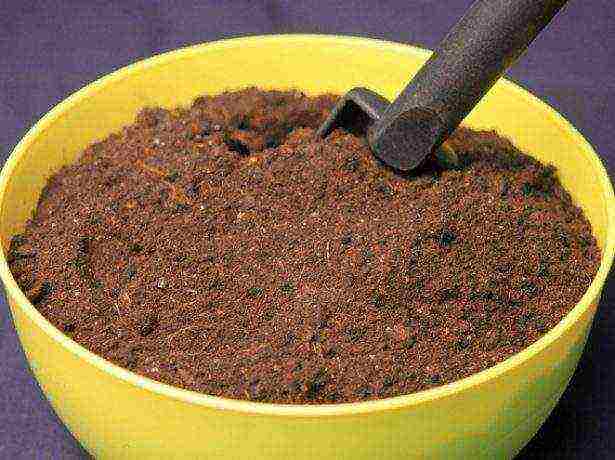
It should, of course, be borne in mind that not every ready-made soil mixture is suitable for growing petunia seedlings.
Did you know: Often petunias do not germinate well because of too acidic soil. The “culprit” of this situation is high-acidity high-moor peat.
First of all, you should pay attention to the type of peat used in the soil mixture. He can be riding (red) or low-lying (black). The soil for growing petunias should not be too acidic, so you need to choose a soil based on lowland peat.
Did you know: You can lower the acidity of the soil by adding lime to it. A teaspoon of limestone or dolomite flour is added to one liter of soil.
The German soil of the Green World brand is well suited for growing petunias. It is also possible to use soil from the Russian manufacturer Pelgorskoye-M.
If you decide to prepare the soil yourself, you will need turf soil, peat and sand. In this case, the sand should be chosen not red, but river sand - white or grayish. Red sand contains too much iron oxide. Mix sand, peat and garden soil in a 1: 2: 2 ratio. All components of the soil mixture must be carefully sieved to remove debris, lumps and pebbles. After that, the soil should be spilled with boiling water or calcined in the oven to destroy all pathogens.
Sowing technique of petunias for seedlings
Petunia seedlings need good lighting. If you have the opportunity to provide the seedlings with additional daylight, you can sow as early as the end of February. Otherwise, it is better to wait until mid-March, otherwise the sprouts will be weak and elongated.
As containers for seedlings, you can use plastic containers (preferably with opaque walls), special seedling greenhouses with cassettes, or sow in peat tablets. Pour drainage on the bottom of the containers, on top - a soil mixture with a thickness of at least six centimeters.
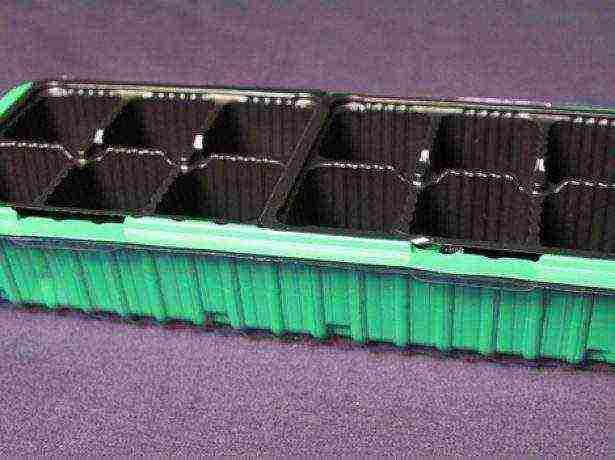
On sale, petunia seeds can be found in two versions: in granules or in bulk.
In granular form, hybrid seeds are most often found. These are very beautiful ampelous, terry, multicolored and other interesting varieties. There is only one drawback of such seeds - high cost. In addition to the higher average price per bag itself, each such bag usually contains from three to seven seeds. However, it can be convenient for planting petunias in pots, balcony boxes and flowerpots. For a flower bed, you will need a lot of such bags.
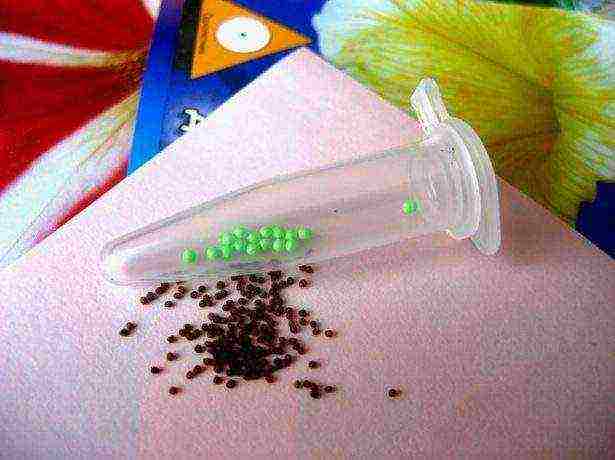
There are many advantages to granulated seeds. First of all, petunia seeds themselves are extremely small, they are much smaller than a grain of sand, and it is difficult to sow them. But sowing granules is extremely simple. It is enough to put the granules on the prepared and moistened soil mixture and slightly press them in (you do not need to sprinkle it with earth, the petunia is sown superficially). The seeds are laid out a few centimeters apart.You can sow directly into pots or cups - two per cup. The seeded granules are covered with plastic wrap. By the way, granulated seeds give on average a higher germination rate than ordinary seeds.
But with seeds in bulk, everything is somewhat more complicated. Here, the inconvenience is offset by the lower cost. In addition, a loose sachet can contain up to several hundred seeds (this information is usually indicated on the package). In this situation, one of the following instructions will come in handy.
Option 1: Mix with sand
- Prepare potting soil and sprinkle it with room temperature water.
- In a flat bowl, combine the seeds with a little sand.

- Spread the resulting mixture on the prepared soil in an even thin layer.
- Spray the crops from above with water from a spray bottle.
Option 2: With tweezers or a toothpick
- Prepare a container of soil. Pour the seeds from the bag onto a white sheet of paper, so you can clearly see them. Prepare two toothpicks and a glass of water.
- Dip the tip of one of the toothpicks into water. Now it will be easy to pick up a petunia seed on it and transfer it to a container. Shake the seed onto the soil with a second (dry) toothpick.
- Sprinkle the sown seeds on top with water from a spray bottle.
Similarly, you can gently transfer the seeds to the soil with tweezers.
Option 3: Sowing in the snow
- Prepare a container with soil, put a thin layer of snow (1-2 millimeters) on top of it.

- Spread the seeds carefully over the snow. The point is that they are clearly visible in the snow, and if the seeds have fallen too thickly, you can redistribute them with tweezers or a toothpick. As it melts, the snow itself will pull the seeds into the soil to the desired depth. You don't need to water anything.
For all sowing options, the seeds are covered with plastic wrap from above.
Sowing seeds in prepared soil mixture or in peat tablets
The soil for sowing seeds should not be alkaline or strongly acidic. Loose, nutritious soil mixtures are used, which are able to retain moisture, but also not freeze at the same time, letting in excess water. A ready-made soil mixture is sold in stores, you can mix a suitable mixture yourself, taking two parts of well-decomposed peat, turf soil, rotted humus and one part of sand. Mix all the ingredients well, sift twice - through a very coarse sieve and through a smaller sieve.
Pour crushed expanded clay into boxes or pots as drainage, on top of expanded clay - large screening of soil mixture, fill the upper third of the container with fine screenings, leaving about 6 cm to the edge. Spread the seeds in even rows over the moistened soil and lightly sprinkle with water on top.

The soil for sowing petunia seeds should not be alkaline or strongly acidic
You do not need to sprinkle the seeds with earth, since they need light for germination. It is enough to lightly press each seed to ensure contact with the ground. If you are interested in how to grow petunia seedlings in the easiest way, use peat tablets instead of seedling containers. They must first be poured with boiled hot water, and then cooled. Small seeds are carefully placed with tweezers in special recesses.
How to properly care for seedlings
The air temperature in the room for growing seedlings should be 20-22 degrees. You need as much light as possible (ideally, backlighting during the day). The substrate should be constantly moist, but at the same time, stagnation of water should not be allowed. Condensation on the lid or foil should be wiped off daily. In addition, you need to take care of hardening the sprouts. To do this, after sprouting, remove the lid for 10 minutes every day. Airing time is gradually increased. You can completely remove the lid or film after all the sprouts acquire real leaves.
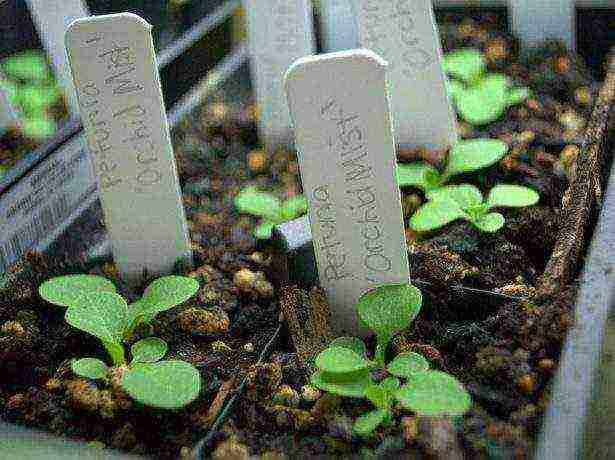
Top dressing at the first stages is not needed, but you can strengthen the immunity of seedlings by adding Epin to the spraying water (a few drops on a spray bottle).
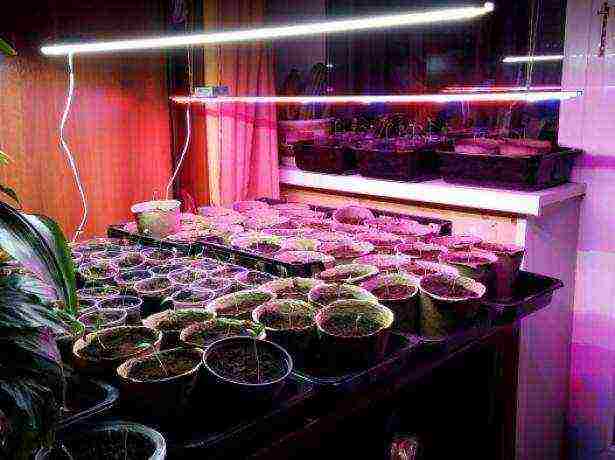
It will be more convenient for the plant to develop in individual containers, it will grow healthier
Seedlings can be dived when their height reaches 4-5 centimeters. Using a narrow knife, remove each sprout, pinching the root at a depth of about three centimeters. After that, each sprout is planted in an individual container.
The main problem that can be encountered when growing petunia seedlings is excessive stretching of the sprouts due to lack of light. You can cope with this problem when diving, by deepening the seedlings into the soil up to the cotyledon leaves.
Granulated seeds can be sown directly into peat tablets - then nothing will have to be dived.
It will be more convenient for the plant to develop in individual containers, it will grow healthier, and it will be easier for you to transplant seedlings into open ground. When picking, deepen the seedling to the first true leaves, so that a good root system is formed and the likelihood of damage to the shoots by the "black leg" is reduced.
Useful tips for growing seedlings
In order for a healthy, beautiful petunia to grow from seeds, the growth of sprouts must be accompanied by regular careful watering. When the soil dries up, the plants will die, and waterlogging will lead to the appearance of a "black leg", and as a result - to rotting and death of small seedlings. Fragile seedlings should be carefully watered at the root.

Top dressing is applied two weeks after plant picking
To harden a young plant from the second week, open the window for 10 minutes, thereby lowering the air temperature in the room. However, in this case, the sprouts must be protected from drafts and direct flow of cold air, the temperature of the seedlings themselves should not drop.
DIY video about growing petunia seedlings
Top dressing is applied two weeks after picking the plants. At first, apply only spraying with leaf fertilizer every two days, alternately changing growth stimulants and complex mineral fertilizers containing nitrogen. In the future, you can add root dressing. Important little things:
- sprouts need light almost around the clock, you will need to provide not only daytime supplementary lighting of seedlings in gloomy weather, but also leave a dim light for the night;
- do not allow a crust to appear on the ground, otherwise the seedlings will suffocate;
- when the roots of the plant fill the entire coma of earth, transplant the petunia into a larger container;
- if you notice that the seedlings are too elongated, add a little potting soil;
- for growing expensive and rare varieties, use peat tablets.
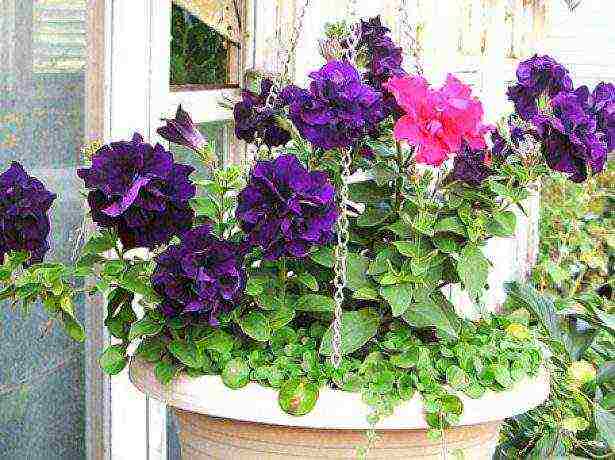
At first, petunia will grow rather slowly, do not worry - the plants will form a root system. In about 1.5 months, the aboveground part will develop no less actively.
How to plant petunia in open ground
At least a week before planting in open ground, seedlings must be taught to new conditions. To do this, the seedlings are taken out to the balcony or veranda every day, increasing the time they spend in the open air every day. Three days before planting, the pots are left to spend the night outside.

It is better to plant seedlings in the evening or on a cloudy day (not in direct sun). For seedlings, holes are prepared at a distance of 18 to 35 centimeters (depending on the variety). Fill the wells with plenty of water. Remove the seedling as carefully as possible from the glass, along with the earthen clod. Dip an earthen ball into the hole, sprinkle with earth and tamp it tightly.
Immediately after planting, the seedlings of petunias must be thoroughly watered.
The article was updated on 29.01.2018 Rate the article:
(32 votes, average: 4.7 out of 5)


